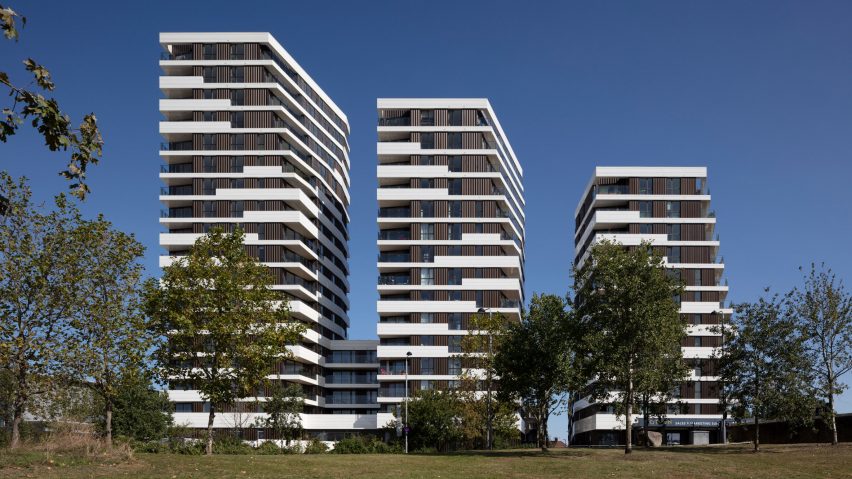Pollard Thomas Edwards has completed a 300-home development in northeast London, comprising two low-rise courtyard blocks and three towers clad in contrasting bands of brown and ivory panels.
Local firm Pollard Thomas Edwards designed the Motion project for developer Hill and housing association Peabody. It is located on a former industrial site opposite the recently upgraded Lea Bridge station in the London Borough of Waltham Forest.
The majority of homes in the development are two-bedroom apartments – 178 in total. There are also 81 apartments with one bedroom, 28 with three bedrooms, one with four bedrooms, and 12 studios.
The buildings are arranged around a gated courtyard garden, with commercial units including a gym, office and shop forming a boundary with the adjacent Lea Bridge Road.
The design of the courtyard buildings references existing local housing in its scale and use of dark brick. The studio said the form and materiality of the blocks "provide a modest and functional backdrop to the striking towers alongside."
The three towers each feature angled cuts intended to add interest to the form and reduce their visual mass. These tapered edges also allow more sunlight to reach the courtyard, balconies and apartments.
The buildings' cladding combines contrasting bands of matte-brown and glossy ivory panels, creating what Pollard Thomas Edwards described as "a contemporary take on Streamline Moderne, a style once used for local landmark buildings."
"The clean cut, bold geometric shapes of the design references the borough's Art Deco heritage in spirit by drawing upon the aspirational, hopeful and optimistic qualities of the Moderne aesthetic," the firm's associate partner Hamish Kilford-Brown told Dezeen.
Kilford-Brown added that the design of the "aerodynamic Smart Deco towers" was also informed by the angular route of the nearby Lee Navigation canalised river and the dynamism of the area's roads and railways.
Overall, the development's aesthetic achieves consistency through its reduced palette of colours and materials.
The courtyard buildings feature a single brick type with subtly different tones, while ridged brown panels set between windows on the towers add texture to the facades.
The pale aluminium panels that wrap around the towers are extended in certain areas to raise the height of bedroom windows and improve privacy for the occupants, a move that Kilford-Brown explained was "a deliberate response to the glut of housing with full-height bedroom windows" which can lead to practical issues relating to overlooking.
Outdoor space was another key consideration when developing the project. In addition to the courtyard garden, residents can access planted rooftop terraces that overlook the neighbourhood.
The scheme is intended as a gateway project for further development to be undertaken by the London Borough of Waltham Forest. With Motion, Pollard Thomas Edwards set out to create what Kilford-Brown called "a memorable group of buildings that would signal the location as a dynamic neighbourhood."
Pollard Thomas Edwards operates a studio numbering more than 150 employees who work on projects ranging from residential developments to public and mixed-use buildings.
The firm was behind the UK's first over-50s co-housing scheme in north London, which comprises brick mews houses arranged around a communal garden.
Photography is by Nick Kane.

